QAM Services Setup
Under the same tab, OAM Services pertaining to 802.1ag, Y.1731, and/or G.8113.1 can be enabled. The tests listed include:
-
Continuity Check (CCM)
-
Loopback (LBM/LBR)
-
Link Trace (LTM/LTR)
-
Loss Measurement (LMM/LMR) (Y.1731 and G.8113.1)
-
Delay Measurement (DMM/DMR) (Y.1731 and G.8113.1)
-
Multi Protocol Label Switching Transport Profile (MPLS-TP) (G.8113.1 only)
General Setup
-
To run any 802.1ag/Y.1731/G.8113.1 test, tap on the checkbox next to the corresponding test.
-
To initiate testing for individual OAM services, press Start next to the desired service (NOT the green start button which initiates Throughput testing).
-
CCM testing is initiated by selecting Enable from a drop-down menu.
Details on individual test parameters will be listed in the specified section.
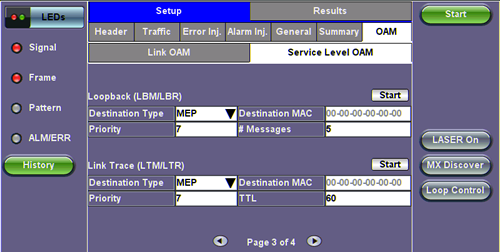
Pressing Start next to Loopback (LBM/LBR) initiates testing for that OAM service
802.1ag/Y.1731/G.8113.1 Connectivity Fault Management Functions
Connectivity Fault Management Functions supported by the test set are as listed:
-
Fault Detection – Continuity Check:
-
CCM "heartbeat" messages are transmitted at a configurable periodic interval by MEPs.
-
-
Network/Path Discovery – Link trace message:
-
Equivalent to a traceroute test. MIPs and MEPs along the path send a response.
-
-
Fault verification and isolation – Loopback:
-
Verify connectivity to a specific point in the message. Equivalent to ping test.
-
Continuity Check Messages (CCM)
CCM Messages are multicast messages sent from MEP to MEP at configurable intervals. Loss of continuity is detected after no CCM is received for 3.5 times the CCM interval.
![]() There can be 4,094 VLANs per port and up to eight maintenance levels. This yields a worst case CCM transmission rate of 9.8 million CCMs per second if 3.3ms interval is used.
There can be 4,094 VLANs per port and up to eight maintenance levels. This yields a worst case CCM transmission rate of 9.8 million CCMs per second if 3.3ms interval is used.

Continuity Check Message (CCM)
RDI Flags added in CCM Messages indicates loss of continuity in the remote direction.
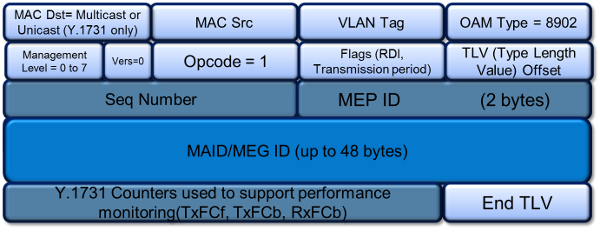
CCM Message Format
CCM Configuration Parameters
-
CCM: Enable/Disable sending Continuity Check messages.
-
Type: Unicast/Multicast. If CCM is set to Enable, this field is ignored. In unicast mode you must enter the MAC address of the destination unit.
-
Priority: 802.1p priority in the CCM VLAN Tag.
-
Tx Interval: Choose from the supported CCM intervals: 1 s, 10 s, 1 min, 10 min.
The CCM Result button is a shortcut that brings the user directly to the CCM Results tab.
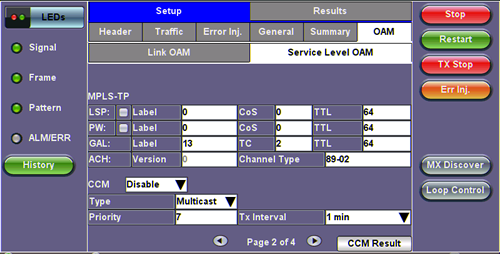
MPLS-TP, CCM Settings - Service Level OAM (Page 2)
G.8113.1 Performance Management Functions
MPLS-TP
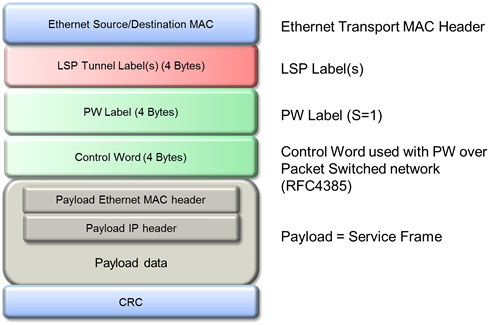
MPLS-TP over Ethernet with PW Label
MPLS-TP is a Layer 2 technology that combines the benefits of MPLS and removes the complexity of IP networking. It uses the MPLS Label switching mechanism, but with static route provisioning (no Label Distribution Protocol LDP or RSVP-TE). MPLS-TP supports an advanced set of OAM functions and path protection mechanisms. In-band OAM traffic is on the same path as data traffic.
Multi Protocol Label Switching Transport Profile (MPLS-TP) Configuration Parameters
-
For the path and tunnel, select LSP (Label Switched Path) and PW (Pseudowire).
-
Label: Configure in the range of 16-1,048,575 (labels 0-15 are reserved).
-
 Composed of 20 bits which allows for the creation of over one million labels.
Composed of 20 bits which allows for the creation of over one million labels. -
CoS: Enter the Classes of Service.
-
TTL: Enter the Time to Live. It will be decremented by 1 each time it crosses a hop. Frame is not forwarded after TTL reaches 0.
-
-
ACH : Enter the Generic Associate Label.
 For Pseudowires, the ACH used the first four bits of the PW control word.
For Pseudowires, the ACH used the first four bits of the PW control word. -
Version: Enter the G-Ach version. The default is set to 0.
-
Channel Type: Enter the channel type (16-bit field).
Link Trace and Loopback Messages
Link Trace Messages (LTM/LTR)
LTM (Link Trace Message) Multicast messages are transmitted on demand to a destination MAC address. All MIPs and destination MEPs respond with LTR (Link Trace Reply) and forward the LTM on to its destination.
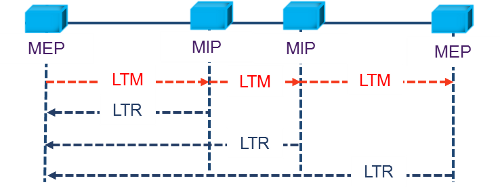
LTM Diagram (LTM/LTR)

Link Trace Message Format

Link Trace Response Format
Loopback Message (LBM/LBR)
LBM (Loopback Message) are unicast messages transmitted on demand to a destination MAC address. A destination address responds with an LBR (Loopback Reply Message).

LBM Diagram (LBM/LBR)

Loopback Message Format

LBM/LBR, LTM/LTR Settings - Service Level OAM (Page 3)
Link Trace (LTM/LTR) and Loopback Message (LBM/LBR) Config. Parameters
-
Destination
-
MEP: Sends LTM/LBM to the destination MEP as configured on Page 1.
-
MAC: Sends LTM/LBM to a destination MAC address.
-
-
Priority: 802.1p priority in the LTM/LBM VLAN Tag.
-
Destination MAC: Configure the destination MAC address used for the LTM/LBM. This field is only used if Destination is set to MAC. If destination is set to MEP, this field is ignored.
-
# Messages: Enter the number of Loopback messages to be sent (LBM test only).
-
TTL: Enter the Time to Live field in the LTM message. TTL will be decremented each time it crosses a hop (MIP) (LTM test only).
Press Start to initiate testing.
Y.1731/G.8113.1 Performance Management Functions
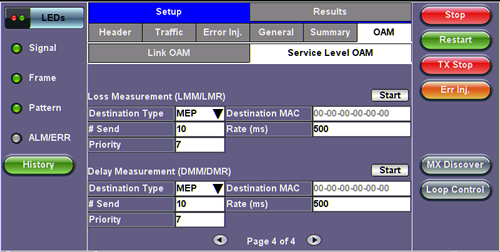
OAM - Service Level OAM (Page 4)
Loss (LMM/LMR) and Delay Measurement (DMM/DMR) Configuration Parameters
-
Destination
-
MEP: Sends LMM/DMM to the destination MEP as configured on Page 1.
-
MAC: Sends LMM/DMM to a destination MAC address.
-
-
Priority: 802.1p priority in the LMM/DMM VLAN Tag.
-
Destination MAC: Configure the destination MAC address used for the LMM/DMM. This field is only used if Destination is set to MAC. If destination is set to MEP, this field is ignored.
-
# Send - Configure the number of LMM/DMM frames to send up to 50.
-
Rate : Configure the LMM/DMM frame interface rate (min: 100 ms; max: 10 seconds).
Press Start to initiate testing.
Frame Loss Measurement
Two local counters for each peer MEP:
-
TxFCf: Counter for in-profile data frames transmitted towards peer MEP.
-
RxFCf: Counter for in-profile data frames received from peer MEP.
Single-ended ETH-LM:
-
On demand OAM.
-
MEP sends LMM frame (Unicast DA or Multicast Class 1 DA) and receives LMR frame (Unicast DA) with counters.
CCM frames contain frame counters.

Single Ended Frame Delay Measurement
LMM frames contain frame counters.
Delay Measurement
On demand OAM for measuring Frame Delay (FD) and Frame Delay Variation (FDV):
-
TxTimeStampf = Timestamp transmission of DMM frame
-
RxTimef = Reception time of the DMM frame
-
RxTimeb = Reception of DMR frame
Two-way ETH-DM:
-
DMM frame (Unicast DA or Multicast Class 1 DA for multipoint measurement) & DMR frame (Unicast DA)
-
FD = RxTimeb – TxTimeStampf

Dual Ended Frame Delay Measurement
DMM and DMR frames contain timestamp info.